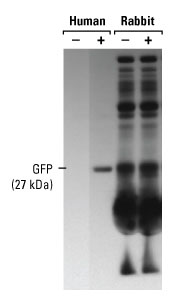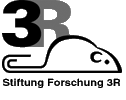
Figure 1

Author: Thermo Scientific Pierce: Human in vitro Protein Expression kit:
http://www.piercenet.com/products/browse.cfm?fldID=EDB3A93E-5056-8A76-4EA0-1F4489020C8A
presented by Peter Maier, 3R Research Foundation Switzerland
The use of a new human cell lysate kit for protein translation will replace the rabbit reticolcyte lysate and the use of rabbits for its production.
Keywords: rabbit; biochemical / analytical; replacement
Method
The new human cell lysate kit (according to the manufacturer) provides more effective, faster, biosynthesized proteins at a high yield and without a high background common to rabbit reticulocyte lysates. Accurate protein translation and efficient post-translational modification are provided by the supplied human cell extracts which contain all of the essential cellular machinery for the cell-free expression of proteins. The system can use either a DNA or mRNA template to synthesize proteins with correct N-linked glycosylation. These extracts provide high yield in-vitro protein synthesis of nearly any target protein in less than 2 hours.
3R effect
Rabbit reticulocyte lysates are worldwide in use as a translational extract from eukaryotic cells. For the production of the rabbit lysates, up to two thousands phenylhydrazine-anemized rabbits are necessary each year. The use of these new human lysates will replace rabbits for lysate production and increases the quality of cell free protein expression.
Figures
The Thermo Scientific Pierce Human In Vitro Expression System enables protein detection by Western blot without background signal.
Expressed GFP was resolved on a 4-12% SDS polyacrylamide gel, transferred onto nitrocellulose and probed with anti-GFP antibodies. Expression of GFP was detected using Thermo Scientific SuperSignal West Dura Chemiluminescent Substrate. Rabbit reticulocyte lysates produce significant background signal; however, the Pierce Human In Vitro Expression System provides low background, detecting the specific protein of interest (deduced from the Thermo Scientific website).

Figure 1